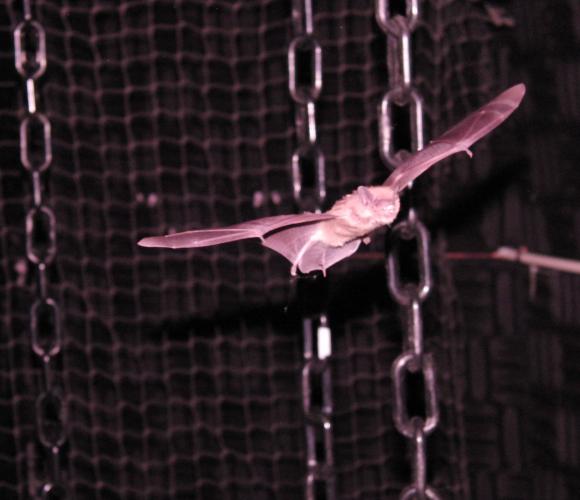PROVIDENCE, R.I. [Brown University] — For years, Brown University neuroscientist James Simmons has filmed bats as they flew in packs or individually chased prey in thick foliage. All the while, he asked himself why the bats never collided with objects in their paths or with each other.
“You wonder, how do they do it?” he said.
After a series of innovative experiments designed to mimic a thick forest, Simmons and colleagues at Brown and in Japan have discovered how bats are so adept at avoiding objects, real or perceived. In a paper published in the Proceedings of the National Academy of Sciences Early Edition, the scientists report that echolocating bats minimize sound wave interference by tweaking the frequencies of the sounds they emit — their broadcasts — to detect and maneuver around obstacles. The scientists also found that bats make mental templates of each broadcast and the echo it creates, to differentiate one broadcast/echo set from another.
The research is important, because it may lead to the design of better sonar and radar systems by capitalizing on the bats’ natural ability to ferret out duplicative echoes in environments that otherwise could produce “phantom” objects.
The group created a 13-row long by 11-row wide U-shaped grid of ceiling-to-floor chain links to test big brown bats’ ability to locate obstacles at various distances in their flight path and to make nearly instantaneous adjustments. The researchers used a miniature radio microphone created by the Japanese authors and attached it to the bats’ heads to record their chirps (which are made in pairs). Other microphones placed in the room recorded the echoes produced from the bats’ broadcasts, giving the researchers a comprehensive, accurate recording of the bats’ echo-processing methods. The scientists also filmed the bats with high-resolution video cameras.
Seeing the forest or the trees
Echolocating bats use rapid-fire broadcast-echo pairs to navigate through forests of obstacles. They make subtle changes in each broadcast to keep the pairs from blurring. These bats were flying at night through a forest in Belize.
Credit: James Simmons/Brown University
The team noticed almost immediately that the bats were confronted with overlapping echoes to their rapid firing of broadcasts. That could create confusion where obstacles were located and even produce objects that weren’t really there.
“When there are a lot of obstacles in the environment, a bat needs to emit sounds quickly,” said Mary Bates, a fourth-year graduate student at Brown and a contributing author on the paper. “It can’t wait for another sound to return before updating its image” (of the scene in which it’s flying).
In other words, an echo from the bat’s first broadcast could masquerade as the echo from a subsequent broadcast. The bat overcomes this potentially confusing cascade of signals by making a template, or mental fingerprint, of each broadcast and corresponding echo, the team learned. That way, the bat needs only to slightly alter the frequency of its broadcast to create a broadcast/echo template that doesn’t match the original. The team found that bats change the frequency of their chirps by no more than 6 kilohertz. That’s a good thing, as bats’ frequency range covers only roughly 20 to 100 kilohertz.
“They’ve evolved this, so they can fly in clutter,” said Simmons, professor of neuroscience. “Otherwise, they’d bump into trees and branches.”
Shizuko Hiryu and Hiroshi Riquimaroux from Doshisha University in Japan are contributing authors on the paper. The research was funded by the National Institutes of Health, the National Science Foundation, the Office of Naval Research, Rhode Island Space Grant, the Japan Society for the Promotion of Science, the Japanese Ministry of Education, Culture, Sports, Science and Technology, the Special Research Grants for the Development of Characteristic Education from the Promotion and Mutual Aid Corporation for Private Schools of Japan and the Innovative Cluster Creation Project.
Audio link: Bat sounds

